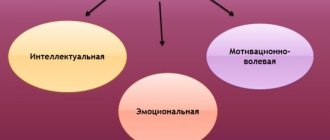Lev Semenovich Vygotsky developed a fundamental theory of the formation and development of higher, specifically human mental functions in a child. Vygotsky’s main idea is about the social mediation of human mental activity. The instrument of this mediation is, according to Vygotsky, a sign (word).
His concept is called “cultural-historical” because, according to this concept, the child’s consciousness, the specific features of his higher mental functions (voluntary memory, voluntary attention) are formed in the child in communication with adults, in which the child assimilates systems of cultural signs developed in the process of socio-historical development. These signs mediate his “lower” (involuntary) mental functions and thereby lead to the creation of completely new formations in the child’s mind.
The main provisions of Vygotsky’s theory on the development of higher mental functions (HMF)
lines of development in human development :
- The natural developmental line is the physical, natural development of a child from the moment of birth.
- Cultural (historical) line of development - arises with the emergence of communication with the outside world.
In the conditions of ontogenetic development, both of these lines - biological and cultural - are in complex interaction, merged, and actually form a single, albeit complex process.
Classification of mental functions
- Lower (elementary) mental functions (LPF) are natural: sensations, perception, children's thinking, involuntary memory.
- Higher mental functions (HMF) are complex, intravitally developing mental processes, social in origin. The distinctive features of HMF are their indirect nature and arbitrariness. These include abstract thinking, speech, voluntary memory, voluntary attention, and imagination.
The child’s higher mental functions arise initially as a form of collective behavior, as a form of cooperation with other people, and only subsequently, through internalization, do they become individual functions themselves, or, as L.S. Vygotsky wrote: “Every function in the cultural development of a child appears on the scene twice, on two levels, first social, then psychological, first between people, as an interpsychic category, then within the child as an intrapsychic category.” The process of formation of the highest mental function is extended over a decade, originating in verbal communication and ending in full-fledged symbolic activity.
Types of higher mental functions
The highest mental functions are the following human cognitive abilities:
speech; praxis; gnosis; memory; attention; intelligence.
Speech
Speech is a historically formed type of communication and interaction in the human community through linguistic constructs that are created and applied according to established canons. Verbal ability involves two processes. The first of them is called expressive speech, which is the formation, formulation and presentation of personal thoughts using linguistic means. The second process is called impressive (sensory) speech, characterized by a person’s ability to perceive audible and visible language structures, to understand the meaning of symbols in oral and written speech.
Praxis
Praxis is the individual’s practical skills of purposeful motor activity, which arose as a result of personal experience and thanks to the professional education received. Such abilities are acquired and accumulated throughout a person’s life. Praxis includes a huge number of simple and complex motor programs regularly carried out by the subject. Examples of motor activity include the skill of walking, which a child masters by the age of one, and complex professional acts, for example, assembling a unit in a certain algorithm of actions. Carrying out complex types of motor activity ensures the correct sequence of muscle contractions of skeletal muscles. The execution of complex acts is ensured by incoming information from proprioceptors and perceived speech signals.
Gnosis
Gnosis is a human cognitive ability that provides the ability to synthesize simple signals from sensory systems into holistic visual, auditory or tactile images. Gnosis ensures the perception of information of any modality and makes it possible to create a coherent picture from heterogeneous signals. Thanks to this highest mental function, the individual not only sees an object, but also recognizes it and distinguishes it from a number of other objects thanks to the coordinated work of individual analyzers and the extraction of the required information from memory.
Memory
Memory is the ability of a subject to assimilate information from life experience, retain information about the phenomena of the surrounding world and the body’s reactions to events that have occurred, repeatedly reproduce and use stored data to solve emerging problems. This cognitive ability also allows you to add and change stored information if necessary.
The conducted studies have established three stages of human memory formation, each of which corresponds to a specific type: sensory, short-term and long-term memory. Sensory memory stores information received from the senses when exposed to certain stimuli. The duration of information storage is minimal: for the duration of the presence of the stimulus, which does not exceed 0.5 seconds. In short-term memory, learned data is stored for no more than twenty seconds. If information is not repeated, then the information is destroyed under the influence of newly received data. In long-term memory, learned data is stored for life.
Attention
Attention is a conscious function that involves the selective direction of perception towards a specific object or phenomenon. With the help of this higher mental function, a search and detection of a signal occurs, followed by maintaining vigilance and identifying the information received
Attention includes two components: involuntary type and voluntary type. Thanks to involuntary attention, adequate and timely perception of stimuli in the surrounding world occurs. Through voluntary attention, a person focuses mental activity to achieve a set goal.
Intelligence
The concept of intelligence implies an individual’s ability to rationally understand the surrounding reality. This function of higher mental activity ensures a person’s adaptation to newly discovered conditions, allows him to learn, understand information and remember the information received. Thanks to intelligence, a person is able to apply learned concepts in practice, can analyze and synthesize information, and is ready to make some conclusions. At its core, intelligence is the totality of all functions of higher mental activity.
The role of the environment in child development
Vygotsky was the first to move from a statement about the importance of the environment for development to identifying a specific mechanism of environmental influence, which actually changes the child’s psyche, leading to the emergence of higher mental functions specific to a person. Vygotsky considered such a mechanism to be the internalization of signs – artificially created man-made incentives and means designed to control one’s own and others’ behavior. HPFs arose with the help of a sign.
Signs are mental tools that, unlike tools of labor, change not the physical world, but the consciousness of the subject operating them. A sign is any conventional symbol that has a specific meaning. The universal sign is the word. The mechanism of change in the child’s psyche, which leads to the emergence of higher mental functions specific to a person, is the mechanism of internalization (appropriation) of signs as a means of regulating mental activity.
Signs, being a product of social development, bear the imprint of the culture of the society in which the child grows up. Children learn signs in the process of communication and begin to use them to manage their inner mental life. Thanks to the internalization of signs, the sign function of consciousness is formed in children, and the formation of such higher mental functions as logical thinking, will, and speech occurs. The use of a sign, a word as a specifically human mental regulator reconstructs all higher mental functions of a person. Mechanical memory becomes logical, the associative flow of ideas becomes productive thinking and creative imagination, impulsive actions become voluntary actions.
Notes
- ↑
- ↑ Leontiev A. N. Development of memory. Experimental study of higher psychological functions // A. N. Leontiev. The formation of activity psychology: early works / Ed. A. A. Leontiev, D. A. Leontiev, E. E. Sokolova. - M. Smysl, 2003. - P. 27-198.
- Zavershneva, E. (2008). Notebooks, notes, scientific diaries of L. S. Vygotsky: results of a study of the family archive (part 2) // Questions of psychology, (2), 120-136
- Vygotsky L. S. Psyche, consciousness, unconscious // Kornilov, K. N. (Ed.). Elements of general psychology (Basic mechanisms of human behavior). M: publishing house BZO at the pedagogical faculty of the 2nd Moscow State University, 1930. Year 1. Issue. 4. pp. 48-61 (republished with distortions in 1982 in Vygotsky’s Collected Works, vol. 1, pp. 132-148
- Compare: “As Vygotsky puts it in a somewhat old-fashioned way
, lower centers serve in the history of development as a prerequisite for the development of higher centers.” See Bernstein, N. A. (1936/2003). Modern research in the physiology of the nervous process. M.: Smysl, S. 235 - Luria, A. R. Traumatic aphasia. Clinic, semiotics and rehabilitation therapy. - M., 1947
Relationship between training and development
Development is a process of quantitative and qualitative changes in the body, nervous system, psyche, and personality. Education is a process of purposeful transfer of socio-historical experience, organization of the acquisition of knowledge, skills and abilities.
Vygotsky identified and summarized the following most widely accepted points of view on the question of the relationship between training and development:
- Training and development are two processes independent from each other . Development is considered as a process that occurs according to the type of maturation, and learning is considered as a purely external use of development opportunities. Training is built on top of development and does not change anything in essence. When analyzing mental development, they try to separate what comes from development and what comes from learning.
- Training and development are two identical processes . A step in learning corresponds to a step in development. A child is only as developed as he is trained.
- Training and development are closely related processes . Development is understood dualistically: there is development as maturation and there is development as learning. On the one hand, development is thought of as a process independent of learning. On the other hand, learning, during which the child acquires new forms of behavior, is identified with development. Development (maturation) prepares and makes possible the learning process, and learning, as it were, stimulates the development (maturation) process. The processes of learning and development are separated, and at the same time their relationship is established.
Vygotsky contrasts these theories with his own, according to which learning and development are not two independent processes or the same process; there is “unity, but not identity, of the learning processes and internal development processes.” According to Vygotsky, it is neither correct to identify the processes of learning and development, nor to assume that the development process occurs independently of the learning process. He argues that there is a complex relationship between learning and development.
Zone of Proximal Development (ZPD)
To explain the question of the influence of learning on development, Vygotsky introduced the concept of two levels of child development :
- The zone of actual development is the level of development already achieved by the child. This is the level of intellectual tasks that he is able to solve completely independently, without the help of an adult. The level of the child’s actual development shows us what mental processes have already developed in him, i.e. in fact, by its current development we can judge the already completed development cycles.
- Zone of Proximal Development (ZPD) . It is revealed not in the child’s independent, but in joint problem solving with adults. The second level is higher than the first, since with the help of an adult the child is able to solve more complex problems. These are discrepancies between the level of actual development (it is determined by the degree of difficulty of problems solved by the child independently) and the level of potential development (which the child can achieve by solving problems under the guidance of an adult and in collaboration with peers). The ZPD defines mental functions that are in the process of maturation. ZPD is a consequence of the formation of higher mental functions, which are formed first in joint activity, in cooperation with other people, and gradually become internal mental processes of the subject.
Vygotsky made the following conclusions: 1) learning creates a zone of proximal development, which then moves into the sphere of actual development; 2) learning moves development forward, relying not only on mature functions, but also on those that are still maturing. Education must come before development. And therefore Vygotsky makes the main conclusion: pedagogy should focus not on yesterday’s, but on tomorrow’s development (i.e., on the child’s zone of proximal development). What a child does today in collaboration with an adult, tomorrow he will do independently. Thus, training and upbringing play a leading role in the mental development of a child.
Vygotsky on the patterns of formation of the HMF.
We will help you write any paper on a similar topic.
- Essay
From 250 rub.
- Test
From 250 rub.
- Course work
From 700 rub.
Receive completed work or specialist advice on your educational project
Find out the cost
Higher mental functions are complex mental processes that are formed during life, social in origin, mediated in psychological structure and arbitrary in the way of their implementation
He considered truly human HMFs to be a product of cultural and historical development. The development of man (unlike animals) occurs thanks to his mastery of various means - tools that transform nature, and signs that rebuild his psyche. A child can master signs (mainly words, numbers) and, therefore, the experience of previous generations only through the learning process. Therefore, the development of the psyche cannot be considered outside the social environment in which sign means are assimilated, and cannot be understood outside of education.
HMFs are first formed in joint activities, cooperation, communication with other people and gradually move to the internal plane, becoming internal mental processes of the child. As Vygotsky writes, “every function in a person’s cultural development appears on the scene twice: first in the social development of the child as interpsychic (acquired), and then on the internal plane as intrapsychic (one’s own).”
First, the adult uses a word to influence the child, encouraging him to do something. Then the child adopts the method of communication and begins to influence the adult with words. And finally, the child begins to influence himself with words.
In this way, HMF are absorbed and not obtained genetically. A child’s speech, for example, is initially only a means of communication with others, and only after going through a long path of development does it become a means of thinking, inner speech, speech for oneself.
The most important characteristic of HMF is their mediation by various “psychological tools” - sign systems, which are the product of the long socio-historical development of mankind. Among the “psychological tools,” speech plays the leading role. The main characteristics of the HPF - mediation, awareness, arbitrariness - are systemic qualities that characterize the HPF. f. as "psychological systems". VMFs as systems have great plasticity and interchangeability of their components. Unchangeable (invariant) in them are the initial task (the conscious goal of the activity) and the final result; the means by which this task is realized are very variable and different at different stages of ontogenesis and with different methods and paths of formation. Vygotsky identified two levels of mental phenomena (“natural” and “cultural” mental processes, believing that the first is determined primarily by the action of genetic factor, and the second is formed entirely under the influence of social influences. Social influences determine the methods of formation of HMFs. and thereby their psychological structure. HMFs are the most universal way of their formation. HMFs are complex systemic formations, qualitatively different from other mental phenomena. They represent are “psychological systems” that are created by superstructure of new formations over old ones, with the preservation of old formations in the form of subordinate layers within the new whole.
Patterns of formation of HMF: 1) initially they exist as a form of interaction between people (i.e., as an interpsychological process) and only later - as a completely internal (intrapsychological) process. The transformation of external means of performing a function into internal psychological ones is called interiorization. 2) characterizing the logic of development of HMFs - their gradual “winding down”, automation. At the first stages of the formation of V. p. f. represent an expanded form of objective activity, which is based on relatively elementary sensory and motor processes; then these actions and processes are curtailed, acquiring the character of automated mental actions. At the same time, the psychological structure of the HMF function changes.
Attention!
If you need help writing a paper, we recommend turning to professionals. More than 70,000 authors are ready to help you right now. Free adjustments and improvements. Find out the cost of your work.
Cost calculationGuaranteesReviews







